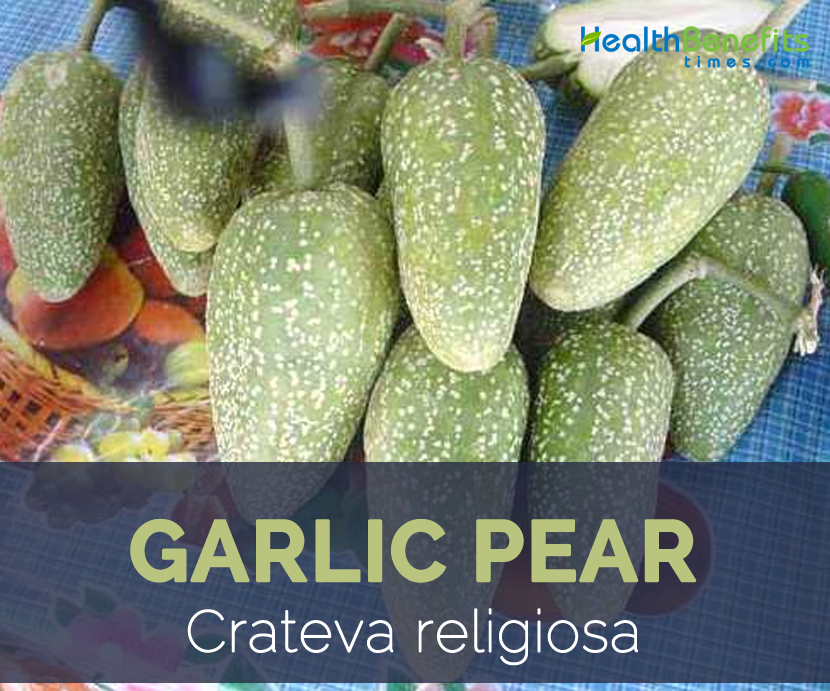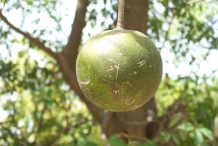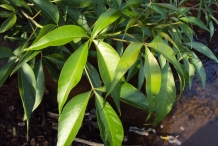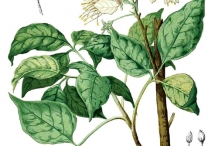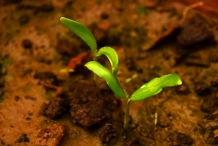Plant
Garlic pear is a moderate sized deciduous tree, 15m (50ft) tall and 9m (30ft) wide. It grows well in sun or partial shade and normally prefers moist, rich, neutral to acid soil. Bark is grey, and the wood is yellowish-white, turning light-brown when old. Leaves are clustered at the ends of branchlets, with a common petiole 5 to 10 centimeters long, at the summit of which are tree leaflets. Leaflets are ovate-lanceolate or ovate, 7.5 to 12 centimeters long, 4 to 6 centimeters wide, and pointed at the base, with a rather slender point at the tip. Flower occur in terminal corymbs, are about 5 centimeters in diameter, greenish-yellow, and the stamens are purplish. The petals are ovate or oblong, with the claw half as long as limb.
Fruit
Garlic pears are rounded or ovoid shaped fruit, and are 3 to 5 centimeters in diameters. The fruit has hard and rough rind and has unpleasant smell and burning taste. The seeds are about 10 centimeters in length, numerous, kidney-shaped, and embedded in a yellow pulp. Tree flowers and fruits in the month of Dec-May
History
Garlic pear scientifically known as Crataeva religiosa is considered to have originated from Japan, Australia, much of Southeast Asia and several South Pacific islands. But now because of its wonderful taste it is globally distributed in India, Myanmar, Sri Lanka, Malaysia, Indonesia and China. In India, it is found in Peninsular India, Western India, Gangetic Plains, and Eastern India, up to Tripura and Manipur. It is also found in Sikkim and Andman and Nicobar Island. It is found mostly along the bank of the river and streams and near to temple side.
Nutritional Value
Apart from their burning taste, garlic pear is a good source of nutrients, vitamins and minerals. Consuming 228 gram of garlic pear offers 123.3 mg of Vitamin C, 3.67 mg of Iron, 12.1 g of Total dietary Fiber, 40.13 g of Carbohydrate, 0.415 mg of Manganese, 107 mg of Phosphorus, 693 mg of Potassium, 0.13 mg of Copper and 55 mg of Magnesium.
Health benefits of Garlic pear
Garlic pears are valuable fruits that have been widely used and appreciated for their wonderful flavor since ancient times. Beyond being a tasty addition to the diet, garlic pears are packed with nutrients and nutritional value. Some of the health benefits of garlic pears include:
1. Immunity
A healthy dose of Vitamin C helps to protect our body from infections and maintains healthy bones and teeth. It also improves our body’s ability to repair wounds and keeps us immune from bacteria, viruses and infection. Not only is it a well-known component of our immune system, it is also necessary for collagen, the main structural protein found in connective tissue. Vitamin C, taken orally, helps wounds heal faster and better. Applied topically, it protects the skin from free radical damage from the exposure to UV rays. From all the above mentioned benefits of vitamin c we can easily say that regular consumption of vitamin C rich foods like garlic pear is quite beneficial for overcoming all the problems.
2. Restless leg syndrome
Iron present in garlic pear is quite essential for proper functioning of the body parts. Iron deficiency may cause several life threatening disease and restless leg syndrome is one of them. Most research on this syndrome has concentrated on iron. Lower level of iron in the blood is actually a major cause and hence proper intake of iron supplements in required levels as per doctor’s consultation can cure this problem. Apart from that regular consumption of iron rich foods like garlic pear is also one of the best options for solving these problems.
3. Weight Loss
High fiber diets are more filling and give a sense of fullness sooner compared to animal and meat based diet. Additionally, the soluble prebiotic fibers have shown to turn off the hunger hormones and to increase the hormones that give a sense of fullness. Those hormones are made in the wall of the gut. New research has shown that the bacterial makeup in the colon in overweight people is abnormal to the extent that they manufacture and absorb almost twice the number of calories as do normal. Prebiotic fibers will help change this bacterial balance in a favorable way. Therefore including fiber rich food such as garlic pear is found quite beneficial for overcoming weight loss goal.
4. Strengthens Bones
Garlic pear consists of good amount of manganese which is quite important for the normal development of the human bone structure. It helps to boost the mineral density of the spine. It has also proved to be helpful for post-menopausal women. Manganese deficiency in women after menopause can increase the amount of trace minerals and cause minor fractures. Research is going on to establish concrete proof that manganese can help prevent osteoporosis and many other diseases. Garlic pear consists of 0.415 mg of manganese which is actually 18.04% of the daily recommended value.
5. Urination and Excretion
Mineral phosphorus present in garlic pear helps in keeping the kidney healthy and its functions active. The mineral ensures the proper release of waste from the kidneys through the process of urination and excretion. Apart from that phosphorus helps to achieve a healthy balance of all fluids and materials that are removed from the body. It helps balance the level of uric acid in the body by increasing the quantity and frequency of urination. It helps in keeping the body toxin-free. It helps regulate the fluid levels in the body.
6. Lower Risk of Heart Problems
Regular consumption of garlic pear is quite beneficial for overcoming hear problems since it consists of good amount of potassium. Taking sufficient amount of potassium will put you at a lower risk of developing heart problems like stroke and heart disease. If you’ve previously been diagnosed with a heart problem, you’ve likely been told to watch your level of potassium.
To complete your heart health profile be sure you’re receiving sufficient amount of exercise each day, such as a walk, strength training, or yoga.
7. Proper Growth
Copper present in garlic pear is quite essential for normal growth and health. Therefore, it is very important to include this mineral in balanced levels in your regular diets. It is also helpful in the protection of the skeletal, nervous as well as cardiovascular systems. If you suffer from a copper deficiency, the normal and healthy growth of organs and tissues, as well as their proper oxygenation from an ample red blood cell concentration, would be impossible. Regular use of garlic pear is also one of the best ways to get required amount of copper.
How to Eat
- Leaves and young shoots are cooked as a vegetable.
- Flowers are pickled.
- Berries and seeds are also edible.
- Young shoots and fruits of Crataeva religiosa are eaten and used in curries.
- Fruits of this tree are used as spice because of its garlic taste.
Other Traditional Uses and Benefits of Garlic Pear
- Bark is used in the urinary disorders like kidney and bladder stones, antiemetic, and calculous affections and as an antidote in snakebite
- Bitter, pungent herb that has diuretic and rubefacient effects, improves digestion, and prevents and treats formation of stones in the kidney and bladder.
- Stem bark is used to encourage the appetite and to decrease the secretion of the bile in unani medicines.
- A preparation called ‘Varunal’ consists of Crataeva along with Eclipts, Picrorrhiza, Achillea, Cichorium, Solanum, Arjuna, and Cassia seeds is used against hepatitis, edema, ascites, urinary stones and arthritis.
- Bark is contraceptive and cytotoxic and useful in kidney bladder stones, fever, vomiting and gastric irritation.
- Roots and bark are laxative and lithontipic and increase appetite and biliary secretion.
- Leaves are used as externally rubifacient and used in rheumatism.
- Leaves are useful in irregular menstruation and also in stomachic, whereas the bark is used to cure convulsions and tympanites in Philippines.
- Crushed leaves are applied in the form of paste for swelling of feet and also for a burning -sensation in the soles of feet.
- Bark and leaves are pounded and applied in the form of a poultice in rheumatism.
- Fresh leaves bruised with little vinegar applied to skin.
- Bark and roots are rubifacient and vesicant.
- Roots and bark in the form of decoction are used as calculus affections.
- It is useful as antipyretic, antilithitic, antihelminthic, and demulcent, in blood and chest diseases.
- Berry like globose fruits of Crataeva is edible and used as astringent and rind of the fruit is used as mordant in dying.
- People use the leaves and bark of this tree to cure jaundice, eczema, rabies in Pallaypatty village of Tamil Nadu.
- Bark of this tree is useful in family planning.
- Juice of fruit, leaves and bark is applied to cure snakebite, infected wounds and cuts.
- It increases appetite and controls other skin diseases.
- Leaves are used as vegetable and the dried leaves are smoked in caries of nasal bones, the smoke being exhaled through the nose in neurologic pains.
References:
https://en.wikipedia.org/wiki/Crateva_religiosa
http://www.flowersofindia.net/catalog/slides/Garlic%20Pear%20Tree.html
http://www.prcupcc.com/herbs/herbsg/garlicpear.htm
http://davesgarden.com/guides/pf/go/71196/
https://npgsweb.ars-grin.gov/gringlobal/taxonomydetail.aspx?id=12158
http://www.jpsr.pharmainfo.in/Documents/Volumes/Vol3Issue01/jpsr%2003110105.pdf
Comments
| Garlic Pear Quick Facts | |
|---|---|
| Name: | Garlic Pear |
| Scientific Name: | Crateva religiosa |
| Origin | Native to Japan, Australia, much of Southeast Asia and several South Pacific islands |
| Colors | Light Green |
| Shapes | Ovoid or rounded, and 3 to 5 centimeters in diameters |
| Flesh colors | Yellow |
| Taste | Burning taste |
| Calories | 157 Kcal./cup |
| Major nutrients | Vitamin C (137.00%) Iron (45.88%) Total dietary Fiber (31.84%) Carbohydrate (30.87%) Manganese (18.04%) |
| Health benefits | Immunity, Restless leg syndrome, Weight Loss, Strengthens Bones, Urination and Excretion, Lower Risk of Heart Problems, Proper Growth |
| More facts about Garlic Pear | |
| Rank | Scientific Name & (Common Name) |
|---|---|
| Kingdom | Plantae (Plants) |
| Subkingdom | Tracheobionta (Vascular plants) |
| Superdivision | Spermatophyta (Seed plants) |
| Division | Magnoliophyta (Flowering plants) |
| Class | Magnoliopsida (Dicotyledons) |
| Subclass | Dilleniidae |
| Order | Capparales |
| Family | Capparaceae (Caper family) |
| Genus | Crateva L. (Crateva) |
| Species | Crateva religiosa G. Forst. (Sacred garlic pear) |
| Synonyms |
|


